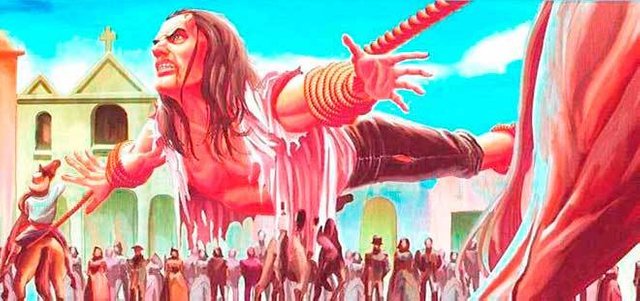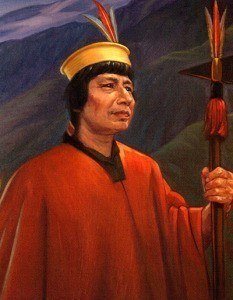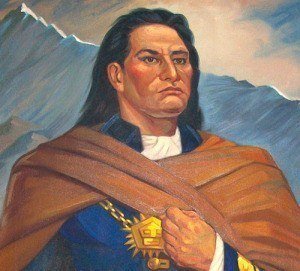Indigenous rebellions of the 18th century

The main causes of the indigenous rebellions during the seventeenth century were the abuse of the corregidores and the discomfort caused by the Bourbon reforms. The viceroyalty endured more than a hundred revolts of different importance, sustained by the popular messianism that awaited the return of the Inca. The ones with the greatest impact among the population were Juan Santos Atahualpa and José Gabriel Condorcanqui (Túpac Amaru II).
Juan Santos Atahualpa
He revolted the Indians of the Gran Pajonal against the Franciscan missions of the area in 1742. Emphasizing his status as Apu Inca and
declaring himself a descendant of Atahualpa, he recruited followers of different mountain and jungle ethnic groups (shipibos, conibos, amueshas, campas). The Indians of the jungle endured devastating epidemics between 1709 and 1737, which arrived with the missionaries and generated a consequent rejection of them.

This, added to a labor system that the natives did not understand or assimilate -represented in the obrajes and haciendas-, determined the acceptance of the insurgent discourse with which they joined the indigenous rebellions.
For Juan Santos, the world was divided into three sovereign kingdoms: Spain, for the Spaniards; Africa, for Africans; and America, for the Indians, mestizos and criollos. It follows that he sought the expulsion of the Spaniards and the Africans of the Andes. However, among the hosts of Indians and mestizos, there were also blacks and zambos. The central jungle became for all of them a refuge zone.
For ten years, the rebel troops made sudden incursions fighting the peninsular army. Finally, in 1752, it leaves the jungle and concentrates on preventing the movement from expanding. The Franciscan missions were abandoned, which stopped the evangelization. The religious did not reenter until 1868, when the city of La Merced was founded in Chanchamayo.
Rebellion of Túpac Amaru II
The rebellion of Túpac Amaru II or Great Rebellion mobilized a considerable amount of Indians and also included groups of creoles, mestizos and blacks. In addition, he had the support of many curacas, among whom the Catari brothers stand out.
Its social base grew along with the discontent generated by the Bourbon reforms: not only had the taxes risen, but the trade with Potosi was damaged when the viceroyalty of Río de la Plata was created (1776).
Tupac Amaru II, prestigious and well-off curaca, spoke out against the tax reforms dictated by Areche and raised his claim before the authorities of Tinta, Cusco and Lima, without any result. Like him, other curacas, mestizos and criollos were unhappy. Thus, a rebellion in Chayanta (Bolivia), which preceded that of Tupac Amaru II, led by Tomás Catari and his brothers Dámaso and Nicolás, raised their complaints against the abuses of the corregidor and the arbitrary change of the ethnic or curaca chiefs. This was exploited by the Peruvian insurgent who offered to the Creoles the abolition of customs and alcabalas; to the mestizos, the elimination of the distribution; and to the Indians, the cessation of tribute and the mining mita of Potosí.

On November 4, 1780, José Gabriel Condorcanqui captured the corregidor Antonio de Aliaga and ordered him to run six days later. At first, Tupac Amaru II revolted against the bad government of the corregidores, but later re-radicalized his position. On November 18, 1780, he defeated the Spanish army in the battle of Sangarará, killing numerous creoles and peninsulares. This distanced him from the white population and the clergy, but it marked the massive adhesion of the indigenous to his cause.
Finally, the troops sent by Viceroy Jáuregui defeated and captured Túpac Amaru in Cuzco, where he was summarily tried. His public execution took place in the central square of the city on May 18, 1781. With him his wife died, Micaela Bastidas; and his eldest son, Hipólito. However, the rebellion continued until November, led by Diego Cristóbal Túpac Amaru.
Aimara Phase: Túpac Catari
The Aymara phase was led by Diego Cristóbal, Miguel Bastidas and Andrés Mendigure. They were joined, in 1781, by the Aymara leader Julián Apaza, known as Túpac Catari.
Unlike Tupac Amaru, the Aymara rebel had no curaca rank. This explains why the second phase of the indigenous rebellions is distinguished, precisely, by the absence of lineage curacas in the movement. Also, the confrontation between Indians and whites led to a rejection of the clergy. Several priests were hanged, among them Father Barriga, a Franciscan religious sacrificed by the Indians on Holy Thursday itself.

From March of 1781 the rebels to the control of Túpac Catari maintained fenced the city of La Paz during 109 days. The shortage of food that originated and the pestilence that followed it exhausted the confused La Paz elite, who could not conceive of being in the hands of the indigenous people. Finally, part of the rebels accepted the pardon by October 1781. Julián Apaza was captured and sentenced to death.
Results of indigenous rebellions
The colonial authorities responded to the indigenous rebellions with a series of measures: speaking in Quechua was prohibited; Inca ornaments would not be used in dresses or ornaments; any anti-literary or literary manifestation that made reference to the Inca past was prohibited, including the reading of the Royal Commentaries of Garcilaso de la Vega; all titles of indigenous nobility were abolished, including that of curaca; they created the Audiencia del Cuzco (1787); and a powerful army of more than 50 thousand men was formed in the viceroyalty, to protect the colonial order.
Hi @aldahyr77, my name is @borges.barilla and I love curate content.
I think your historical text is well written, and able to catch attention along reading. It would be nice to have some references and crosslinks to other posts related to this theme. It would motivate some extra discussion.
You are receiving an upvote from me (~0.05$) hoping it will motivate you to keep producing valuable content and contributing to the Steemit Community.
In future, as you produce new content, type @borges.barilla in the comment from your own post. This will make me know you have added a new post, so I can read, evaluate, and upvote in case you produce valuable content.
In case you appreciate this effort, please follow me.
Great content will always be Resteemed.
See you around!
b.b.
Congratulations! This post has been upvoted from the communal account, @minnowsupport, by CryptoLeader from the Minnow Support Project. It's a witness project run by aggroed, ausbitbank, teamsteem, theprophet0, someguy123, neoxian, followbtcnews, and netuoso. The goal is to help Steemit grow by supporting Minnows. Please find us at the Peace, Abundance, and Liberty Network (PALnet) Discord Channel. It's a completely public and open space to all members of the Steemit community who voluntarily choose to be there.
If you would like to delegate to the Minnow Support Project you can do so by clicking on the following links: 50SP, 100SP, 250SP, 500SP, 1000SP, 5000SP.
Be sure to leave at least 50SP undelegated on your account.
You got a 6.25% upvote from @brupvoter courtesy of @aldahyr77!
Congratulations @aldahyr77! You have completed the following achievement on Steemit and have been rewarded with new badge(s) :
Click on the badge to view your Board of Honor.
If you no longer want to receive notifications, reply to this comment with the word
STOPTo support your work, I also upvoted your post!
Congratulations @aldahyr77! You have completed the following achievement on Steemit and have been rewarded with new badge(s) :
Click on the badge to view your Board of Honor.
If you no longer want to receive notifications, reply to this comment with the word
STOP